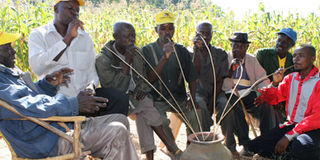Scientists say busaa linked to oesophageal cancer

Residents of Shibuli village, Lurambi Division, in Kakamega enjoying their busaa. Scientists have now said that the popular brew could be linked to oesophageal cancer. Many brewers have been found to use rotten maize, which increases the presence of toxins. PHOTO | FILE
What you need to know:
- A study shows the brew is in many instances found to contain harmful toxins.
- Many brewers use rotten maize to make busaa.
- The habit of drinkers of taking the brew from different brewers exposes them to higher risk.
- It should be brewed using clean ground maize, millet and sorghum and promptly consumed to reduce the presence of toxins.
The popular traditional busaa brew has been linked to cases of oesophageal cancer.
In a study, five scientists have raised a red alert over the continued consumption of the highly popular home-made brew, saying it was a major cause of oesophageal cancer.
Releasing the findings of a study carried out on the maize-based fermented brew, the scientists blamed high concentrations of chemicals, especially multiple Mytoxins-Aflatoxin (93 per cent), Fumonisin (9.8) per cent and Deoxynevalenol (DON) (23 per cent), in all the 61 samples collected from various consenting brewers.
The study was carried out in Bomet in a mainly rural area where busaa brewing is done by women as a source of income.
“The co-occurrence of multiple Mytoxins even in low quantities may have higher toxicity with serious health consequences for regular busaa consumers.
PROLONGED EXPOSURE
Although exposure to low levels of toxins is not harmful, prolonged exposure to these toxins may lead to long-term negative effects attributed to high cases of oesophageal cancer among busaa drinkers,” the report says.
The report further says that the situation is made worse by the drinkers’ habit of moving from one drinking joint to another, thereby exposing themselves to various types of toxins that adversely affect their well-being.
It warns that since brewers prefer using rotten maize and some low-cost animal feeds, imbibers of traditionally prepared brews must be told that the “purity of their favourite drink is determined by purity of the ingredients they use.”
The researchers — Ms Mary Kirui, Mr Amos Alakonya and Keith Talam, all from Jomo Kenyatta University of Technology and Agriculture, working jointly with the Kenya Medical Research Institute’s Ms Christine Bii and Gonoi Tohru from Japan’s Chiba University’s Mycology Centre — said there was a need for the quality of local brews to be checked and carefully analysed to safeguard people’s lives.
CONSUME PROMPTLY
The report says that busaa — which is highly esteemed in Kenya’s rural areas, where it is consumed during weddings, funerals, male circumcision ceremonies and dowry payment among other communal ceremonies — should be brewed using clean ground maize, millet and sorghum and promptly consumed to reduce the presence of toxins.
“Aflatoxins are known to be immune suppressants, carcinogenics, mutagenics and teratogenics, while Fumonicins are strongly associated with oesophageal cancer and neural tube defects in humans.
On the other hand, Deoxynevalenol (DON) is manifested in vomiting, diarrhoea and even weight loss,” it says.
The analysis carried out at Kemri laboratories found that rotten cereals that ought to be discarded ended up being fed to livestock while the rest was sold to brewers at throwaway prices.
The brews under review had a high toxic level, above the limits set by the European Union.
The report, extensively covered in the academicjournals.org website, says that busaa should not be ignored as it portends a grim future for imbibers of the brew.





